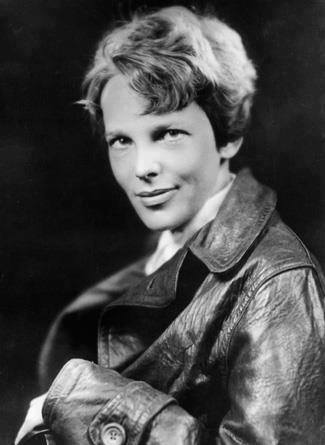
Today in Feminist History is our daily recap of the major milestones and minor advancements that shaped women’s history in the U.S.—from suffrage to Shirley Chisholm and beyond. These posts were written by, and are presented in homage to, our late staff historian and archivist, David Dismore.
June 29, 1937: “I’ll be in the United States in four days,” said Amelia Earhart early this morning, just before she and navigator Fred Noonan took off from Port Darwin, Australia.

Thus began the final, and most challenging part of their around-the-world flight. Every mile after Port Darwin is over vast stretches of water, and requires finding and then landing on islands until they arrive back in Oakland, California, where they began on May 20.
Fortunately, the first island they needed to find was a large one—New Guinea—and the flight to Lae was only 1,207 miles, ending safely 7 hours and 43 minutes after it began. But their next hop will be over twice as long—2,556 miles—and the target will be a 450-acre—seven tenths of a square mile—dot in the South Pacific called Howland Island.
This will be her second attempt to fly there, the first ending in a runway crash on takeoff from Hawaii. That was actually the second near-disaster of her ill-fated first effort. After setting the record for the fastest flight from Oakland to Hawaii, it was found upon landing that the propeller bearings were almost dry. Had that not been discovered, and her takeoff to Howland been successful, she might have suddenly gone down at some remote location in the Pacific with no one ever knowing what happened to her.
That first attempt—in which she flew in a Westerly direction—obviously had to be abandoned, and the plane returned to the U.S. for extensive repairs before starting the trek again. This time she’s circling the globe by going East due to the prevailing winds being different in June than in March.
After Howland, it’s on to Hawaii—1,900 miles) and Oakland—a 2,410-mile flight from Hawaii. According to Earhart:
“From Lae to Howland Island will be the worst section of the flight, but with Freddy Noonan navigating, I’m confident we will make it.”
When she arrived in Port Darwin yesterday, after a 500-mile flight from Timor, in the Dutch East Indies, she said:
“It’s been a very interesting flight. But for slight mechanical trouble, which was remedied in Bandoeng, Java, we have experienced no hold-ups. We’ve been sitting down waiting for Australia to turn up and we’ll push on to Lae, New Guinea. I’m not taking any risks, but am flying as fast as possible.”
She has been writing regular reports on her flight, eagerly read in newspapers around the U.S. This is a sample from yesterday:
“PORT DARWIN (Northern Territory, Australia) June 28.
“We crossed the Timor Sea from Koepang on Timor Island, in 3 h. 29 m., against strong head winds. We flew over fleecy clouds at a height of 7,000 feet, and possibly this was one reason why we saw no sharks, concerning which everyone had warned us.
“The country hereabout is very different from that surrounding Koepang. There, jagged mountains rose against the dawn, while here, as far as one can see, are endless trees on an endless plain.
“Tomorrow we must be off at dawn. I fear I must leave Australia without seeing a koala bear or Miss Jean Batten [flyer]. I hope to return some time to accomplish these two desires.”
Tonight, mechanics are doing an extremely thorough check of her plane. If there are no mechanical problems found, and no weather delays, she and Noonan will take off as soon as possible for Howland. They are determined to stay on schedule for what should be a well-attended, well-deserved and triumphant reception when they land in Oakland and become the first to fly around the world as close to the Equator as possible.
Earhart has not been specific about her post-flight plans beyond saying that she is looking forward to enjoying the Independence Day holiday with her husband, George Palmer Putnam. But her strong and long-time commitment to equality for women in general, and to the Equal Rights Amendment in particular, should insure that she will have plenty of work ahead, even if, as she said recently:
“I have a feeling that there is just about one more good flight left in my system and I hope this trip is it. Anyway, when I have finished this job, I mean to give up long-distance stunt flying.”





